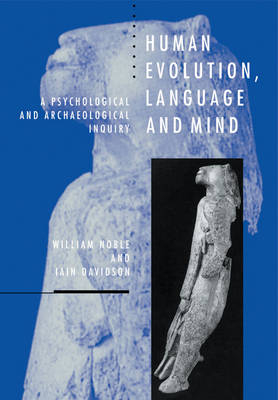
Human Evolution, Language and Mind
A Psychological and Archaeological Inquiry
Seiten
1996
Cambridge University Press (Verlag)
978-0-521-57635-2 (ISBN)
Cambridge University Press (Verlag)
978-0-521-57635-2 (ISBN)
This interdisciplinary text explores the significance, nature and timing of the evolutionary emergence of human behaviour, which the authors argue is based in linguistic behaviour. The book includes surveys of the archaeological evidence and an impressively broad range of relevant literature.
The question of how modern human behaviour emerged from pre-human hominid behaviour is central to discussions of human evolution. This important book argues that the capacity to use signs in a symbolic way, identified by the authors as language, is the basis for behaviour that can be described as human. The book is the product of a unique collaboration between the key disciplines in the debate about human evolution and mentality - psychology and archaeology. It investigates the significance and nature of the emergence of linguistic behaviour. The text critically examines the archaeological record of hominid evolution and argues that linguistic behaviour emerged no earlier than 100,000 years ago. The book's interdisciplinary approach allows critical attention to be given to an impressively broad range of relevant literature. For the first time, all the known pieces of this evolutionary puzzle are examined in detail.
The question of how modern human behaviour emerged from pre-human hominid behaviour is central to discussions of human evolution. This important book argues that the capacity to use signs in a symbolic way, identified by the authors as language, is the basis for behaviour that can be described as human. The book is the product of a unique collaboration between the key disciplines in the debate about human evolution and mentality - psychology and archaeology. It investigates the significance and nature of the emergence of linguistic behaviour. The text critically examines the archaeological record of hominid evolution and argues that linguistic behaviour emerged no earlier than 100,000 years ago. The book's interdisciplinary approach allows critical attention to be given to an impressively broad range of relevant literature. For the first time, all the known pieces of this evolutionary puzzle are examined in detail.
List of illustrations; List of tables; Preface; 1. An evolutionary approach to the origin of mind; 2. The common ancestor of humans and other apes; 3. Symbols and their significance; 4. Constructing 'the mind'; 5. Communication, perception and symbol use: the place of meaning; 6. The early signs of meaning in prehistoric behaviour; 7. Behaviour that led to language: Nariokotome to Neanderthal; 8. The origin of symbol-making; References; Index.
| Erscheint lt. Verlag | 26.7.1996 |
|---|---|
| Zusatzinfo | 8 Tables, unspecified; 4 Maps; 9 Halftones, unspecified; 39 Line drawings, unspecified |
| Verlagsort | Cambridge |
| Sprache | englisch |
| Maße | 152 x 229 mm |
| Gewicht | 430 g |
| Themenwelt | Geisteswissenschaften ► Archäologie |
| Naturwissenschaften ► Biologie ► Humanbiologie | |
| Sozialwissenschaften ► Ethnologie | |
| Sozialwissenschaften ► Soziologie | |
| ISBN-10 | 0-521-57635-0 / 0521576350 |
| ISBN-13 | 978-0-521-57635-2 / 9780521576352 |
| Zustand | Neuware |
| Haben Sie eine Frage zum Produkt? |
Mehr entdecken
aus dem Bereich
aus dem Bereich
23 Techniken, um Stress abzubauen, Negativspiralen zu unterbrechen …
Buch | Softcover (2023)
FinanzBuch Verlag
CHF 25,20
produktiv sein ohne Stress – und mehr vom Leben haben
Buch | Softcover (2023)
dtv Verlagsgesellschaft
CHF 25,20
Wie Myrmecophile mit ihren Wirten interagieren
Buch | Softcover (2023)
Springer (Verlag)
CHF 97,95


